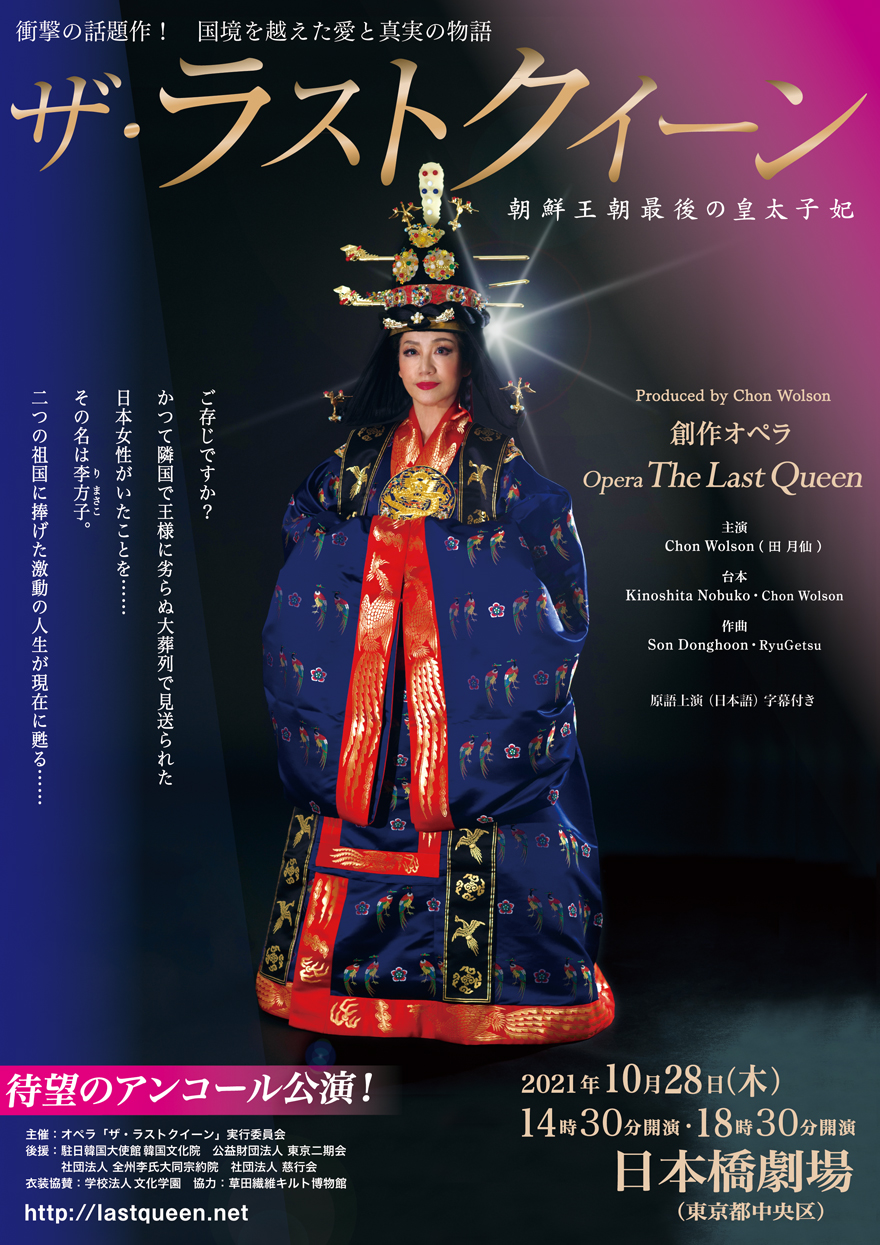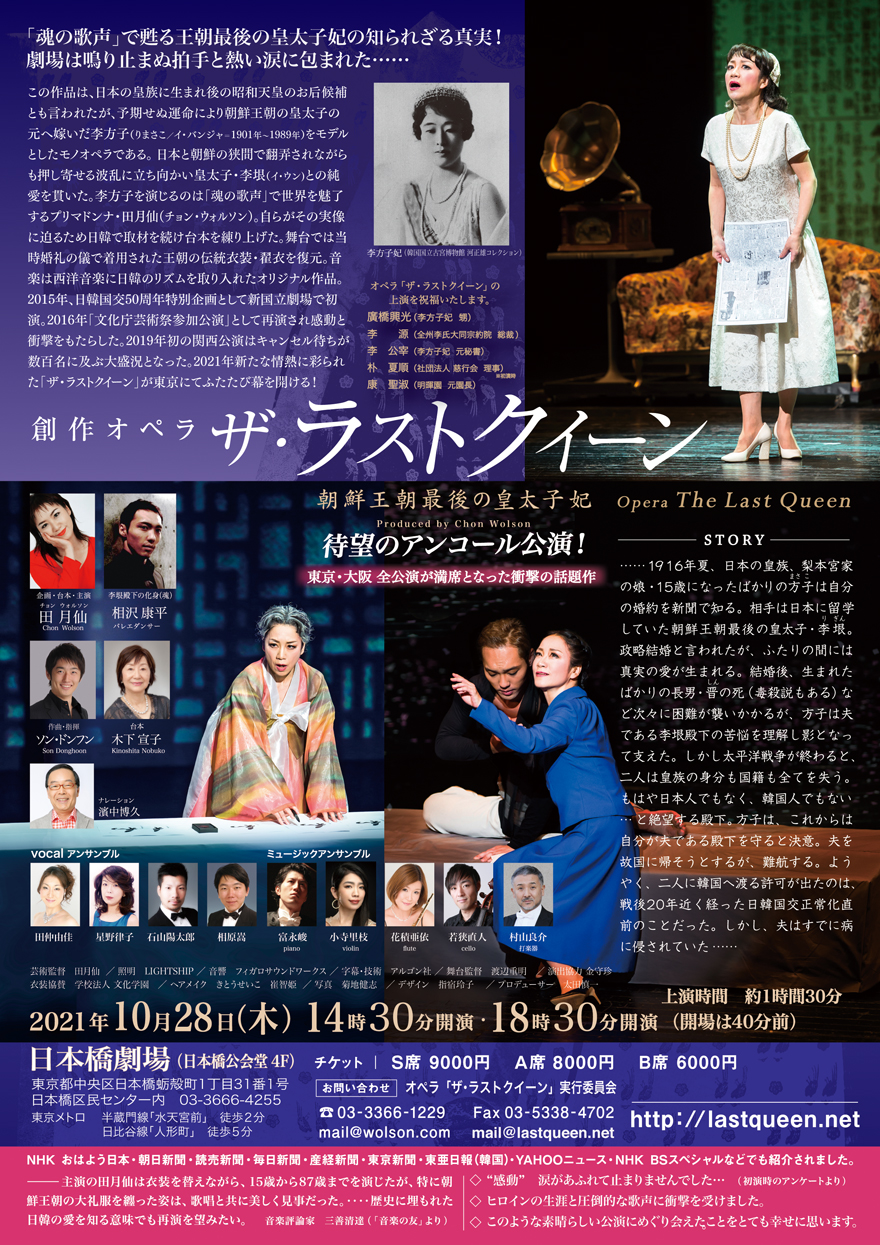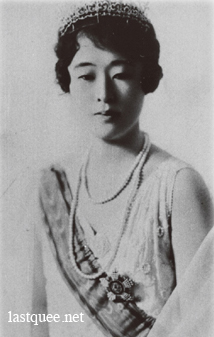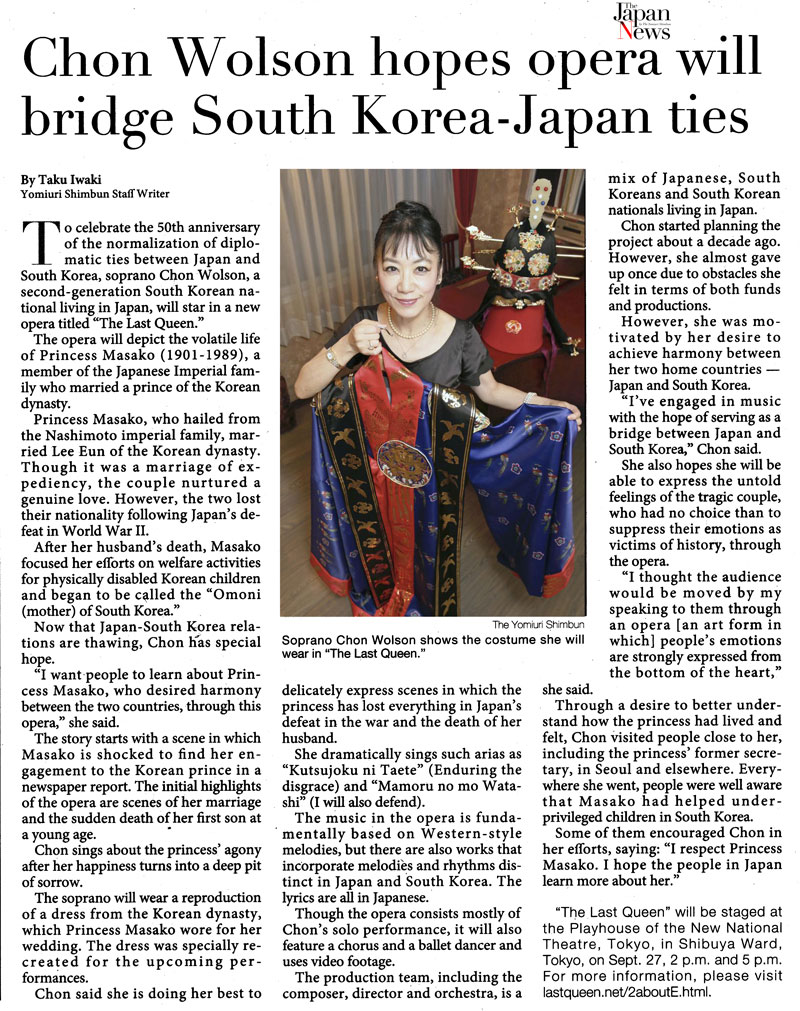produced by Chon Wolson
Opera “The Last Queen”
The Chosen Dynasty's last Crown Princess
Brought back by popular demand
from Thursday , 28 , Oct, 2021 Tokyo


|
|||||
|
|
Yi Bangja (Li Masako) 1901-1989
She was born into the Japanese Imperial Family as the daughter of Prince Nashimoto, and had been considered a candidate to marry then-Crown Prince Hirohito (later the Showa Emperor), but in 1920 she married Crown Prince Yi Un of Korea, the heir to the former imperial thrown of Korea, which was now incorporated into Japanese royalty. Following the annexation of Korea by Japan, this marriage was seen as strategic in promoting harmony between Japan and Korea. |
Chon Wolson and the original opera “The Last Queen”
“The Last Queen” is an original creation that Chon Wolson has been planning for the past ten years, and it is coming to fruition to commemorate the 50th anniversary of the normalization of relations between Japan and the Republic of Korea. In the more than 30 years since her debut, Chon Wolson has not only performed operatic arias, but also has introduced audiences to songs from Japan and the Korean peninsula, to much critical acclaim. She performs Korean and Japanese songs regularly alongside operatic arias at her recitals. She methodically seeks out songs to do this. She finds songs immersed with history, listens to what people connected with the song have to say, imagines the feelings of the people included in the song, and then gives it her own interpretation. What motivated her to start seeking out these songs was a Japanese song she was to sing in 1998 when Japanese cultural goods were liberalized in South Korea was forbidden. Before that, she had already uncovered the song “Korei Sanga, Waga Ai,” which led her to seek out other banned songs. Then in 2006, she published her non-fiction book “Aria of the Straits,” drawing on the lives of the people of in the narrow space of Japan and the Korean Peninsula her own impressions. The book received an award, and she followed it up with a history of musical exchange between Japan and Korea called “The Forbidden Songs” (published by Chuo Koron) and another about deep connections between K-pop and Japanese songs called “Distant memories of K-pop” (published by Shogakkan), both of which viewed the two nation’s history from a musical perspective. Even historical witnesses who are usually tight-lipped opened up to Wolson, who has lived a life straddling Japan and the two Koreans. And this year she carries this work forward to culmination in the original opera “The Last Queen.” The libretto for “The Last Queen” is based on lost sources that were dug up as well as new information acquired by actually walking around various locations in Japan and Korea in order to paint an accurate picture of Masako Lee. As for the costume, it is being made realistically based on a reproduction of Masako Lee’s actual gown that cost tens of millions of yen to produce following the return of the original gown by the government of Japan to South Korea in 1990. (The original relic is stored in the National Palace Museum of Korea and is closed to the public.) Access to the reproduction was secured with the cooperation of the Education Foundation Bunka Gakuen. The music for the opera is also original and modern and makes use of Korean rhythms and Japanese melodies. |
|
Date of performance: |
Thursday,28 , Oct, 2021 14:30 18:30 |
Place of performance: |
|
Ticket |
S 9000 yen / A 8000yen / B 6000yen CALAF.NET
|
Inquiries: |
The Last Queen Executive Committee |
Chon Wolson hopes opera will bridge South Korea-Japan ties JAPAN NEWS The Yomiuri Shimbun |
The opera will depict the volatile life of Princess Masako (1901-1989), a member of the Japanese Imperial family who married a prince of the Korean dynasty. Princess Masako, who hailed from the Nashimoto imperial family, married Lee Eun of the Korean dynasty. Though it was a marriage of expediency, the couple nurtured a genuine love. However, the two lost their nationality following Japan’s defeat in World War II. After her husband’s death, Masako focused her efforts on welfare activities for physically disabled Korean children and began to be called the “Omoni (mother) of South Korea.” Now that Japan-South Korea relations are thawing, Chon has special hope. “I want people to learn about Princess Masako, who desired harmony between the two countries, through this opera,” she said. The story starts with a scene in which Masako is shocked to find her engagement to the Korean prince in a newspaper report. The initial highlights of the opera are scenes of her marriage and the sudden death of her first son at a young age. Chon sings about the princess’ agony after her happiness turns into a deep pit of sorrow. The soprano will wear a reproduction of a dress from the Korean dynasty, which Princess Masako wore for her wedding. The dress was specially re-created for the upcoming performances. Chon said she is doing her best to delicately express scenes in which the princess has lost everything in Japan’s defeat in the war and the death of her husband. She dramatically sings such arias as “Kutsujoku ni Taete” (Enduring the disgrace) and “Mamoru no mo Watashi” (I will also defend). The music in the opera is fundamentally based on Western-style melodies, but there are also works that incorporate melodies and rhythms distinct in Japan and South Korea. The lyrics are all in Japanese. Though the opera consists mostly of Chon’s solo performance, it will also feature a chorus and a ballet dancer and uses video footage. The production team, including the composer, director and orchestra, is a mix of Japanese, South Koreans and South Korean nationals living in Japan. Chon started planning the project about a decade ago. However, she almost gave up once due to obstacles she felt in terms of both funds and productions. However, she was motivated by her desire to achieve harmony between her two home countries — Japan and South Korea. “I’ve engaged in music with the hope of serving as a bridge between Japan and South Korea,” Chon said. She also hopes she will be able to express the untold feelings of the tragic couple, who had no choice than to suppress their emotions as victims of history, through the opera. “I thought the audience would be moved by my speaking to them through an opera [an art form in which] people’s emotions are strongly expressed from the bottom of the heart,” she said. Through a desire to better understand how the princess had lived and felt, Chon visited people close to her, including the princess’ former secretary, in Seoul and elsewhere. Everywhere she went, people were well aware that Masako had helped underprivileged children in South Korea. Some of them encouraged Chon in her efforts, saying: “I respect Princess Masako. I hope the people in Japan learn more about her.” “The Last Queen” will be staged at the Playhouse of the New National Theatre, Tokyo, in Shibuya Ward, Tokyo, on Sept. 27, 2 p.m. and 5 p.m. For more information, please visit lastqueen.net/2aboutE.html.Speech |


